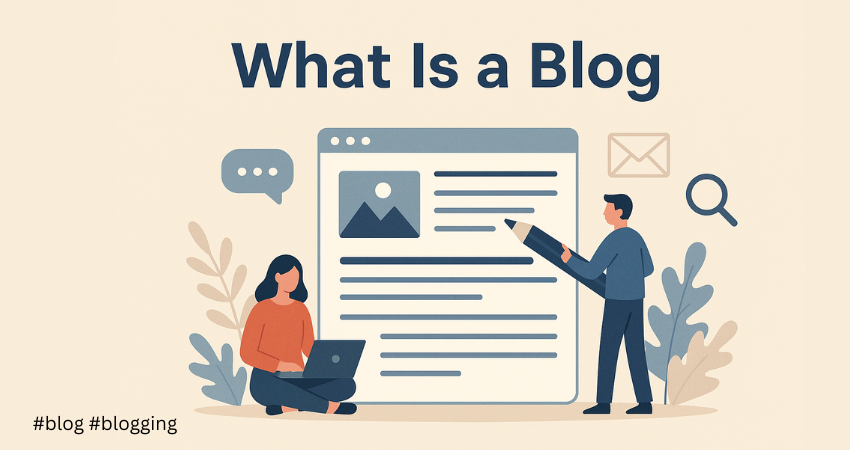What Is a Blog?

You’ve probably come across blog posts while Googling something simple—like “how to write a pitch email” or “best tools for freelance writers.” But have you ever paused to think, what exactly is a blog? Is it just another form of writing? Or is it something more? For many freelancers, small businesses, and personal brands, blogging is more than just publishing articles. It’s a tool to share insights, attract readers, showcase expertise, and yes—build an income stream. And if you’re just starting out or switching lanes in your writing career, understanding the purpose of a blog (and how it’s different from content writing) can make all the difference. This post is your beginner-friendly guide to what blogging really is, how it fits into the broader content landscape, and the 9 types of blogs you should know before hitting “publish.” Key Takeaways A blog is your digital voice. It helps you connect with your audience, showcase expertise, and grow your brand or career. Blogging isn’t the same as content writing. Blogs are one form of content writing—more personal, educational, and story-driven. Choosing the right blog type matters. Knowing your blog’s purpose—whether it’s niche, personal, or professional—helps shape your content and attract the right readers. So, What Is a Blog? A blog is a regularly updated section of a website—or a standalone site—where individuals or businesses publish content in the form of articles (called blog posts). These posts are usually focused on a specific topic or theme, and are written in a conversational, informative, or storytelling tone. At its core, a blog is a tool for: Sharing ideas or experiences Educating or guiding a specific audience Building credibility in a chosen field Attracting traffic through search engines and social shares Unlike static web pages, blogs are dynamic—they grow with time, adapting to the writer’s voice, goals, and audience needs. In plain terms: A blog is your digital space to talk to your audience. It could be about content strategy (like here on mayapillaiwrites.com), writing tips, branding advice, or simply documenting your journey as a freelancer. How Blogging Is Different from Content Writing Let’s clear something up—blogging and content writing are not the same, even though they often overlap. Content writing is a broader umbrella that includes all types of written material created for digital platforms: website copy, product descriptions, newsletters, social media captions, case studies, and more. Blogging, on the other hand, is a specific type of content writing that typically focuses on educating, informing, or engaging an audience through longer-form articles published on a blog section of a website. While content writing is often structured for conversion or performance (e.g., getting someone to buy, sign up, or click), blog writing is more reader-centric—it aims to build trust, deliver value, and encourage repeat visits. Blogs allow for a personal voice, storytelling, and perspective that might not always fit in a more formal or transactional piece of content. For example, a blog post might explore “Why Freelancers Should Build a Personal Brand,” while content writing might involve writing a homepage section titled “About Our Team.” Both are essential in a digital strategy—but they serve different goals, formats, and tones. Aspect Blogging Content Writing Goal To inform, engage, or guide readers To market, convert, sell, or explain Tone Friendly, opinion-based, or story-driven Varies—can be formal, persuasive, technical, or concise Format Articles posted on websites Includes blog posts, website copy, emails, product pages, etc. SEO Importance High—especially for traffic Very high across most formats Reader Interaction Common—through comments or shares 9 Common Types of Blogs (with Real-Life Examples) Whether you’re planning to build your authority, grow an audience, or just document your journey, the type of blog you choose will shape your voice, tone, and reach. Here are the most popular blogging types—with examples to help you visualise the possibilities. 1. Personal Blogs These are intimate, reflective spaces where writers share thoughts, life experiences, lessons learned, and personal stories. Examples: Cup of Jo – A lifestyle and motherhood blog that feels like chatting with a friend. Zen Habits by Leo Babauta – Focused on mindfulness, simplicity, and intentional living. Rukmini Ray Kadam’s blog – Indian blogger writing about everyday reflections, writing, and life. 2. Professional or Business Blogs Used by solopreneurs or businesses to position themselves as experts, attract leads, and provide valuable insights to potential clients. Examples: Neil Patel’s Blog – A digital marketing hub for SEO, content, and growth strategies. FreshBooks Blog – Covers productivity, invoicing, and freelance finance management. Mayapillaiwrites.com – Offers guidance to content writers and builds an ecosystem for writers and clients. 3. Niche Blogs These cater to a specific audience or interest area. The more focused the topic, the more targeted the readers. Examples: The Review Hive – A cybersecurity-focused blog covering software reviews and industry updates. Minimalist Baker – Specialises in simple, plant-based recipes for home cooks. Mr. Money Mustache – Focused exclusively on financial independence and frugal living. 4. Affiliate Blogs These blogs earn through commissions by recommending products or services through tracked affiliate links. They often focus on reviews, listicles, or comparison posts. Examples: The Wirecutter (by NYT) – Recommends tech and home products with detailed reviews. TechRadar – Reviews gadgets, software, and tech services with affiliate links. ShoutMeLoud by Harsh Agrawal – Covers blogging tools and affiliate marketing strategies. 5. Educational Blogs These blogs are built to teach, train, and offer actionable resources—especially valuable for service-based businesses or creators. Examples: Copyblogger – Offers lessons on persuasive writing, copywriting, and content strategy. HubSpot Blog – Covers inbound marketing, sales funnels, and CRM education. ProWritingAid Blog – Teaches grammar, editing techniques, and writing best practices. 6. News and Commentary Blogs These keep readers up to date with trends, current events, or offer strong viewpoints on recent happenings in a particular industry. Examples: Search Engine Journal – News on Google algorithm updates and digital marketing. TechCrunch – Tech startup news and industry trends. Cybersecurity News section on The Review Hive – Covers ransomware, scams, and breach reports
10 Blogging Mistakes That Cost You Readers

Blogging can be rewarding—but only if you avoid the traps that stall progress. When I started, I made plenty of mistakes—some minor, others that cost me valuable time, traffic, and confidence. If you’re just starting out or even a few posts in, chances are you’re unknowingly walking into some of these same pitfalls. That’s why I’ve put together this list—not as a critic, but as someone who’s been there, learned the hard way, and wants to help you get it right faster. Let’s uncover the 10 common blogging mistakes you should steer clear of—and what to do instead. 1. Not Having a Niche You can’t be everything to everyone—find your focus. One of the biggest traps bloggers fall into is writing about everything under the sun. When your blog lacks a clear focus, readers don’t know what to expect. Choose a niche you’re knowledgeable about and passionate about—whether it’s tech, wellness, parenting, or productivity. This helps you attract a loyal audience and strengthens your authority. 2. Ignoring What Your Audience Wants Your blog should serve your readers, not just your creativity. Blogging for yourself may feel liberating, but your readers are here to find value. Do some research. What questions are they asking on forums? Which of your posts perform best? Use tools like Google Trends, AnswerThePublic, or social media polls to find out what your audience truly wants—and write with that in mind. 3. Neglecting SEO Best Practices Great content means nothing if no one finds it. There are many competitors in the market. Readers generally go through the first two or three pages of the search engine results. Put effort in finding which topics are in demand. Your blog should load fast. For your information site loading speed is a major factor in determining the rankings of the site. Include the focus keyword in the URL, title, headings, and sub-headings. The focus keyword should be put in a few places in the blog too. Avoid keyword stuffing as this practice is penalized by search engines. Tools like Yoast SEO and Ubersuggest can help optimize your content without overwhelming you. 4. Using Uninspiring Titles Most people judge a book by its cover. A boring or unclear title will not encourage readers to read the blogs. The title should be catchy and encourage readers to want to read the blog. Use numbers or intriguing questions to capture attention. First impression counts. For example Your blog title is the first (and sometimes only) chance to hook your reader. Use numbers, power words, or curiosity-driven phrases. Instead of “How to Blog Better,” try “10 Blogging Mistakes That Cost You Readers” or “How I Fixed My Blog After Months of Zero Growth.” 5. Writing Very Long Blogs Get to the point—your readers are busy. Most readers do not have patience to read long blogs. So cut down on the fluff. Make sure you include the most relevant and important information. If you have more to say, break it into a series. Tip: Add relevant images and infographics if possible 6. Ignoring the Mobile Audience Most of your audience reads on the go—design for it. Most people browse blogs through their respective mobiles. Your blog should be optimized such that text and images load fast on mobiles. The blog should be easy to read as well as navigate. This will ensure a sizable and loyal audience. Then you are on your way to having a successful blog. 7. Not Updating Old Content Do not keep on churning blogs. Periodically go through the older blogs and see if it is still up to date. Put efforts to make sure the blogs include current developments. Update relevant information and consider internal linking to the other blogs on your website. 8. Blogging Without a Schedule Consistency builds trust—sporadic posting breaks it. Do not post blogs whenever you feel like. Blog posting should be regular and consistent. To help yourself keep a content posting calendar. Have a list of topics to write on ready for a month or a whole year. Some readers will be looking forward to read your blogs. Posting consistently will keep them happy and loyal. 9. Expecting Quick Results Success takes time—stay in the game. You are not the only blogger in the market. Making a name in any field takes time. Rome was not built overnight. Perseverance is key to the success of your blogging efforts. Monetization of your blog also takes some time. 10. Copying Other Bloggers’ Style Readers crave authenticity, not replicas. The audience do not want to read what is already there in other blogs. Try to give unique content or a fresh perspective. Be inspired by other blogs but have an original style. Share your personal experiences or honest opinions to make your blog useful as well as attractive. Bonus Mistakes to Watch Out For Skipping proofreading and publishing with typos Choosing a confusing or unappealing domain name Using poor-quality hosting that slows your site Not promoting your blog on social media Ignoring reader comments or feedback Final Thoughts Every blogger stumbles. What matters is that you learn, adapt, and keep writing. Avoiding these mistakes won’t just help your blog grow—it will help you grow as a writer and creator. What was the biggest blogging mistake you’ve made? Share it in the comments—it might save someone else the trouble.
